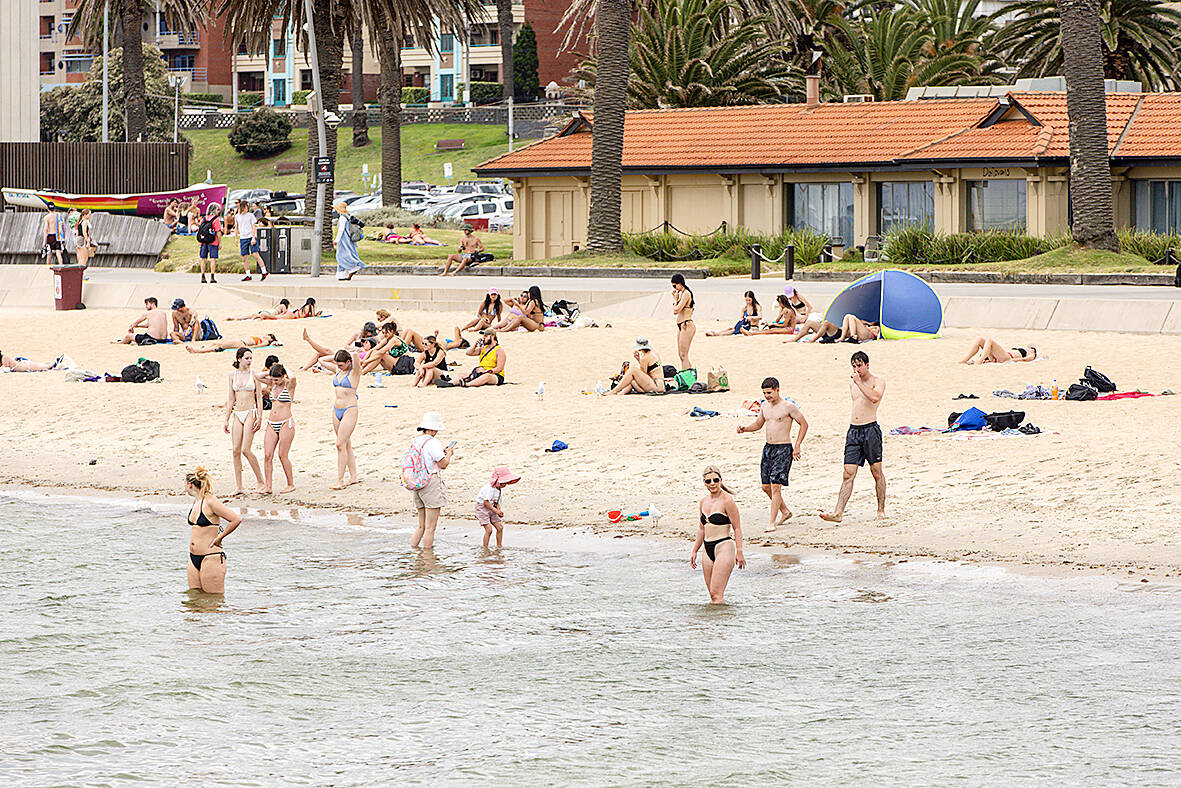The world has been getting hotter for decades but a sudden and extraordinary surge in heat has sent the climate deeper into uncharted territory — and scientists are still trying to figure out why.
Over the past two years, temperature records have been repeatedly shattered by a streak so persistent and puzzling it has tested the best-available scientific predictions about how the climate functions.
Scientists are unanimous that burning fossil fuels has largely driven long-term global warming, and that natural climate variability can also influence temperatures one year to the next. But they are still debating what might have contributed to this particularly exceptional heat surge.

Photo: EPA-EFE
Experts think changes in cloud patterns, airborne pollution and Earth’s ability to store carbon could be factors, but it would take another year or two for a clearer picture to emerge.
“Warming in 2023 was head-and-shoulders above any other year, and 2024 will be as well,” Gavin Schmidt, director of the NASA Goddard Institute for Space Studies said last month.
“I wish I knew why, but I don’t,” he added. “We’re still in the process of assessing what happened and if we are seeing a shift in how the climate system operates.”
‘UNCHARTED TERRITORY’
When burned, fossil fuels emit greenhouse gases like carbon dioxide that trap heat near the Earth’s surface.
As fossil fuel emissions have risen to record highs last year, average sea surface and air temperatures have curved upwards in a consistent, decades-long warming trend.
But in an unprecedented streak between June last year and September this year, global temperatures were unlike anything seen before, said the World Meteorological Organization — and sometimes by a considerable margin.
The heat was so extreme it was enough to make last year — and then this year — the hottest years in history.
“The record global warmth of the past two years has sent the planet well into uncharted territory,” said Richard Allan, a climate scientist from the UK’s University of Reading.
What occurred was “at the limit of what we would expect based on existing climate models,” said Sonia Seneviratne, a climatologist from ETH Zurich in Switzerland.
“But the overall long-term warming tendency is not unexpected” given the amount of fossil fuels being burned, she added.
’DIFFICULT TO EXPLAIN’
Scientists said that climate variability could go some way to explaining what happened.
Last year was preceded by a rare, three-year La Nina phenomenon that had a strong cooling effect on the planet by pushing excess heat into the deep oceans.
This energy was released back to the surface when an opposite, warming El Nino event took over in the middle of the year, boosting global temperatures.
But the heat has lingered even after El Nino peaked in January.
Temperatures have not fallen as fast as they rose, and last month was still the second-warmest on record.
“It is difficult to explain this at the moment,” said Robert Vautard, a member of the UN’s climate expert panel IPCC. “We lack a bit of perspective. If temperatures do not drop more sharply in 2025, we will really have to ask ourselves questions about the cause,” he said.
JURY OUT
Scientists are looking for clues elsewhere.
One theory is that a global shift to cleaner shipping fuels in 2020 accelerated warming by reducing sulphur emissions that make clouds more mirror-like and reflective of sunlight.
Another peer-reviewed paper this month looked at whether a reduction in low-lying clouds had let more heat reach Earth’s surface.
At the American Geophysical Union conference this month, Schmidt convened scientists to explore these theories and others, including whether solar cycles or volcanic activity offered any hints.
There are concerns that without a more complete picture, scientists could be missing even more profound and transformational shifts in the climate.
“We cannot exclude that some other factors also further amplified the temperatures... the verdict is still out,” said Seneviratne.
Scientists this year warned that Earth’s carbon sinks — such as the forests and oceans that suck CO2 from the atmosphere — had suffered an “unprecedented weakening” last year. This month, the US National Oceanic and Atmospheric Administration said the Arctic tundra, after locking away C02 for millennia, was becoming a net source of emissions.
Oceans, which have acted as a massive carbon sink and climate regulator, were warming at a rate scientists “cannot fully explain,” said Johan Rockstrom of the Potsdam Institute for Climate Impact Research.
“Could this be a first sign of a planet starting to show a loss of resilience? We cannot exclude it,” he said last month.

That US assistance was a model for Taiwan’s spectacular development success was early recognized by policymakers and analysts. In a report to the US Congress for the fiscal year 1962, former President John F. Kennedy noted Taiwan’s “rapid economic growth,” was “producing a substantial net gain in living.” Kennedy had a stake in Taiwan’s achievements and the US’ official development assistance (ODA) in general: In September 1961, his entreaty to make the 1960s a “decade of development,” and an accompanying proposal for dedicated legislation to this end, had been formalized by congressional passage of the Foreign Assistance Act. Two

March 31 to April 6 On May 13, 1950, National Taiwan University Hospital otolaryngologist Su You-peng (蘇友鵬) was summoned to the director’s office. He thought someone had complained about him practicing the violin at night, but when he entered the room, he knew something was terribly wrong. He saw several burly men who appeared to be government secret agents, and three other resident doctors: internist Hsu Chiang (許強), dermatologist Hu Pao-chen (胡寶珍) and ophthalmologist Hu Hsin-lin (胡鑫麟). They were handcuffed, herded onto two jeeps and taken to the Secrecy Bureau (保密局) for questioning. Su was still in his doctor’s robes at

Last week the Democratic Progressive Party (DPP) said that the budget cuts voted for by the China-aligned parties in the legislature, are intended to force the DPP to hike electricity rates. The public would then blame it for the rate hike. It’s fairly clear that the first part of that is correct. Slashing the budget of state-run Taiwan Power Co (Taipower, 台電) is a move intended to cause discontent with the DPP when electricity rates go up. Taipower’s debt, NT$422.9 billion (US$12.78 billion), is one of the numerous permanent crises created by the nation’s construction-industrial state and the developmentalist mentality it

Experts say that the devastating earthquake in Myanmar on Friday was likely the strongest to hit the country in decades, with disaster modeling suggesting thousands could be dead. Automatic assessments from the US Geological Survey (USGS) said the shallow 7.7-magnitude quake northwest of the central Myanmar city of Sagaing triggered a red alert for shaking-related fatalities and economic losses. “High casualties and extensive damage are probable and the disaster is likely widespread,” it said, locating the epicentre near the central Myanmar city of Mandalay, home to more than a million people. Myanmar’s ruling junta said on Saturday morning that the number killed had